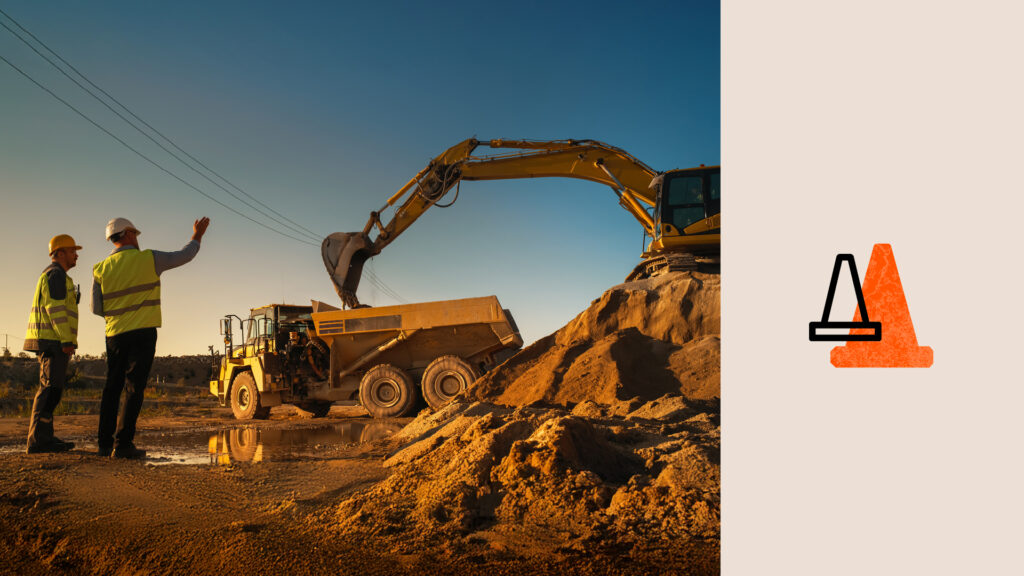— 4 min read
34 Key Construction Safety Statistics
Last Updated May 7, 2025

Worker safety is consistently one of the top priorities on any construction project, and with good reason. While technologies for safety and risk analysis tools have made enormous strides in recent years, the building industry remains among the most dangerous in the world.
Since 2008, construction has experienced more total deaths than any other industry (and that figure doesn’t include fatalities from suicide — of which this industry also has the most). Construction professionals have higher injury rates than most other professions and experience some of the highest rates of alcohol abuse. And if they survive a full career on the jobsite, workers can expect an increased risk of hearing impairment, mobility problems and respiratory issues.
Here are 34 statistics about construction safety to put the scope of the problem into perspective.
Table of contents
Fatality Statistics
1,075: Annual number of deaths in construction (2023) 1
2. Construction accounts for 20% of all deaths among US workers (2023) 1
3. Death rate in construction: 9.6 per 100,000 workers (2023) 2
4. 1,029: Number of preventable deaths (2023). 3
5. 65% of all construction deaths result from a Focus Four incident (2023) 4
- Falls (including slips and trips): 35%
- Struck-by incidents: 17%
- Electrocution: 7.6%
- Caught incidents: 5.8%
- All other injuries: 34.5%
6. 1 in 3 fatal falls are from roofs 5
Injury Statistics
7. 173,200: Total recorded injuries in construction (2023) 6
8. Approximately 14% of all construction workers have hearing difficulty (2024) 7
9. About 25% of noise-exposed tested construction workers have a material hearing impairment. Hearing impairment is hearing loss that impacts day-to-day activities. (2024) 7
Mental Health Statistics
10. 56 per 100,000 workers: male suicides attributed to construction and extraction workers in 49 U.S. states (2021). 8
11. Four reasons why construction workers may not seek care for mental health or substance abuse issues: 9
- Shame and stigma
- Fear of judgment by peers
- Fear of negative job consequences
- Don't know how to access care
12. 16.5%: The rate of heavy alcohol use among U.S. construction workers in 2012. Construction has the second-highest rate of heavy alcohol use among all industries. 10
Safety Inspections
13. 31,700: The number of annual OSHA inspections in construction (2024) 11
14. 15,900: The number of annual OSHA citations in construction (2024) 11
15. $127.4 million: Annual OSHA penalties (2024) 11
16. $4,018: Average OSHA penalty per inspection (2024) 11
17. $8,012: Average penalty per citation (2024) 11
18. $165,514: The maximum OSHA penalty for each willful or repeated violation (2025) 12
19. $8.35 million: The highest OSHA penalty ever issued to a single contractor 13
20. The most common OSHA citation in construction is for failure to provide fall protection (2024) 14
Safety Costs
21. $5 billion: The annual cost of construction-related deaths, measured in lost production, lost family income and pain and suffering (2017) 15
22. $7.87 billion: The cost of workers’ compensation direct costs from the top five injury causes in construction (2020) 16
Go beyond OSHA regulations.
The Procore Safety Qualified program provides construction professionals with everything they need to know to create a culture of safety.

Safety Programs
Contractors currently have training programs on: 17
23. Personal Protective Equipment (PPE): 91%
24. Fall protection: 88%
25. Ladder safety: 79%
26. Power tool safety: 75%
27. Noise & hearing protection: 73%
Percentage of construction firms that: 17
28. Designate competent project safety personnel: 70%
29. Conduct ongoing job safety analysis during construction: 68%
30. Conduct ongoing job hazard analysis during construction: 65%
Impacts of safety programs: 17
31. Ability to negotiate better insurance terms: 78%
32. Willingness of jobsite workers to report unsafe work conditions: 75%
33. Improved standing in the industry: 73%
34. Recordable injury rates: 73%
Safety culture in construction is changing.
Construction workers have long had a reputation for stubbornness and stoicism, at times to a fault. Compliance with safety rules — like wearing hard hats and tethers — carried a stigma among some hard-nosed old-timers, often preventing widespread adoption. Fortunately, times are changing in many ways. PPE, safety harnesses and high-visibility vests seem to be more prevalent — and proudly worn — on more jobsites than ever.
Today’s construction leaders recognize the impact of investing in a culture of safety — not just on the jobsite, but in the back office as well. Construction software enables construction workers to streamline their processes, with documents such as daily logs, safety reports, and site plans more accessible (and in one place) for project stakeholders. When each employee has a responsibility for safety —whether completing a daily site inspection or analyzing safety performance data to predict future risks — everyone becomes part of the solution.
Sources
1. US Bureau of Labor Statistics (BLS), Census of Fatal Occupational Injuries, Summary 2023, 2023.
2. BLS, Number and Rate of Fatal Work Injuries, by Private Industry Sector, 2023
3. National Safety Council (NSC), Work Safety Introduction, 2023.
4. CPWR, Fatal and Nonfatal Focus Four Injuries in Construction, 2023.
5. CPWR, Fatal Falls from Roofs, 2013.
6. BLS, Number and Rate of Nonfatal Work Injuries and Illnesses in Private Industries, 2023
7. CDC, Noise and Hearing Loss - Construction Statistics, 2024.
8. Center for Disease Control, Suicide Rates by Major Occupational Group, 2021.
9. Workplace Mental Health, Mental Health and Well-Being in the Construction Industry, 2021.
10. Substance Abuse and Mental Health Services Administration, Substance Use and Substance Use Disorder by Industry, 2015.
11. CPWR, OSHA Inspections and Citations in Construction, 2024.
12. OSHA, Penalties, 2025.
13. OSHA, Top Enforcement Cases Based on Total Issued Penalty.
14. Occupational Safety and Health Administration (OSHA), Commonly Used Statistics, 2024
15. Midwest Economic Policy Institute, The $5 Billion Cost of Construction Fatalities in the United States, 2017.
16. Liberty Mutual, Workplace Safety Index 2020: Construction, 2020.
17. Dodge Data & Analytics, Safety Management in the Construction Industry 2021, 2021.
Was this article helpful?
Thank you for your submission.
95%
5%
You voted that this article was . Was this a mistake? If so, change your vote here.
Scroll less, learn more about construction.
Subscribe to The Blueprint, Procore’s construction newsletter, to get content from industry experts delivered straight to your inbox.
By clicking this button, you agree to our Privacy Notice and Terms of Service.
Categories:
Tags:
Written by
Jonny Finity
28 articles
Jonny Finity creates and manages educational content at Procore. In past roles, he worked for residential developers in Virginia and a commercial general contractor in Bar Harbor, Maine. Jonny holds a BBA in Financial Economics from James Madison University. He lives in New Orleans.
View profileLiana Harlan
Liana Harlan is a seasoned web designer and content strategist with over two decades of experience in creating engaging digital experiences and effective communication strategies. Based in Central California, Liana has been leveraging her skills in content strategy, web design, and copywriting as a freelance writer since 2023.
View profileExplore more helpful resources

On the Safe Side: Using Data to Boost Subcontractor Safety
Capturing data to mitigate the safety risks incurred by subcontractors as well as in-house workers demands proactive risk management measures, transparent change management and methodical strategy. Applying data to safety...

Top Techniques for Heavy Equipment Safety & Operations
Nearly 1 of every 5 workplace fatalities occurs in the construction industry. It is increasingly important to create a culture of safety and reduce the risk of workplace accidents, and...

Preconstruction Partnerships: How Safety Pros Can Collaborate with Estimating & Proposal Teams
Construction leaders and safety professionals are developing a strong understanding of how safety programs positively impact project outcomes. When safety is woven into every aspect of operations from pre-construction to...

The Strategic Partnership Between Construction Safety and HR
A construction safety manager’s role is significant: It entails broad oversight over the construction workplace to prevent incidents that could cause worker injury or property damage. In addition to this...
Free Tools
Calculators
Use our calculators to estimate the cost of construction materials for your next project.
Templates
Find a template to help you with your construction project tasks.
Material Price Tracker
Get the latest U.S. retail prices and view historical trends for common building materials.
Glossary
Explore key terms and phrases used in the industry.